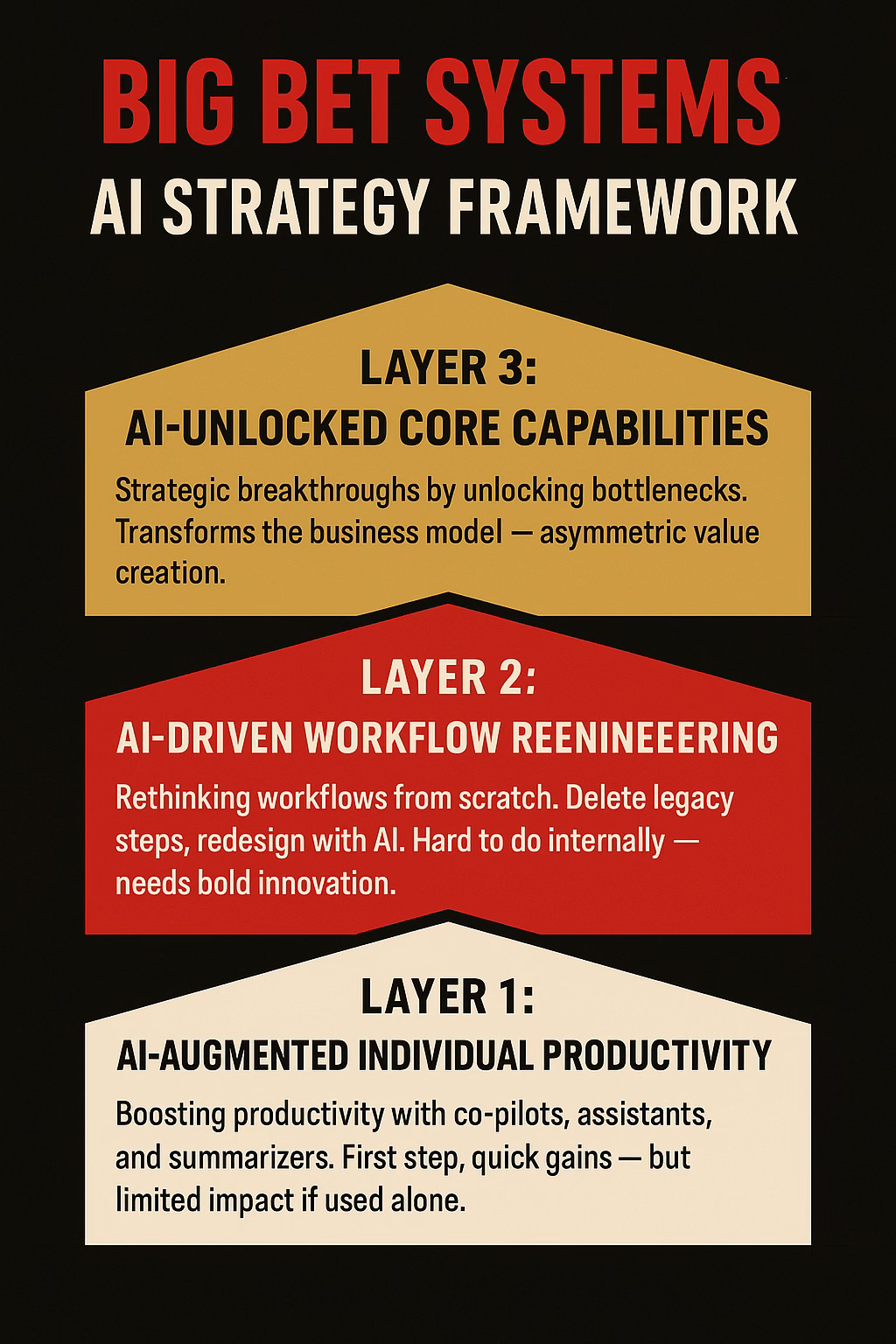Pancakes: The AI Strategy Framework I’ve Been Holding Back
“It’s about damn time” — Lebron James
I couldn't have said it better myself. It's about damn time I outlined a Big Bet System™ framework tailored specifically to create and execute a coherent AI strategy for your business —one that stacks up properly.
Yes, I know — I've talked about it, advised on it, dropped hints in keynotes, but the playbook needed to be published. Think of this as finally sharing the recipe after perfecting it in the kitchen.
Why now? Because as the capabilities of AI continue to advance at lightning speed and some distinct patterns. 99% of companies, even the most aggressive and nimble of all of them, struggle in creating and maintaining momentum.
They're flipping pancakes one at a time instead of building a proper stack. The fundamental truth of innovation and transformation — "experimentation" and “success” is based off back of failure. We have to have critical thinking, design of experiments coupled with dogged determination to design true competitive advantage.
The rewards are asymmetrical relative to the costs, and the alternative of not developing a thoughtful AI strategy will, sooner than later, will not only sacrifice competitive advantage, but lead to a highly disadvantaged business. This is the "wicked problem" and high-stakes situation that Big Bet Leadership is designed to handle.
In this article, I'll lay out the core framework: the Big Bet Systems™ AI Strategy—served up in three delicious layers.
And if you're wondering what took me so long to map this out… well, let's just say I've been experimenting with a few "Un-carrier Moves" of my own. Sometimes the best recipes take time to get right.
But First — The Bitter Lesson
If you listen to the All In Podcast, there was recently a profound segment. In it, they discuss “the bitter lesson” and how almost all companies are approaching their AI strategy with yesterday’s human-centric thinking.
The Bitter Lesson: Why Computation Beats Human Expertise in AI
AI researcher Rich Sutton's influential 2019 essay1 reveals a counterintuitive truth that business leaders should understand: the general methods that leverage computation are ultimately the most effective, and by a large margin.
Sutton traces a consistent pattern across AI breakthroughs in AI chess, Go, speech recognition, and computer vision. In each case, researchers initially tried to encode human expertise and domain knowledge into their systems. While this approach provided short-term improvements, it ultimately hit walls.
The breakthrough moments came when researchers abandoned human-centric approaches and instead embraced massive computational power through search algorithms and machine learning. Deep Blue beat Kasparov not through chess strategy, but through brute-force calculation. Modern speech recognition dominates not by mimicking human understanding, but by processing vast datasets.
The 40 Year-Old Secret to Unlock Your AI Strategy
An hour lost at a bottleneck is an hour lost for the entire system." - Eliyahu Goldratt
The Business Implication
For leaders, this suggests a fundamental shift in how to think about AI investment and strategy. Rather than focusing on systems that replicate human thinking or encode expert knowledge, the winning approach is to build systems that can scale with increasing computational power.
The Bitter Truth
Why is this lesson "bitter"? Because it means that decades of work trying to make AI systems think like humans was largely wasted effort. It also means that over-steering AI with our logic, rules or traditions limits the effectiveness of AI now and will not take advantage of computing advances in the future. You’ve put a limit to the height of your pancake stack!
The takeaway for business: bet on scalable, general-purpose AI methods rather than narrow, expertise-driven solutions. The future belongs to AI use-cases that get better simply by throwing more computing power at them.
As we discussed in this recent episode “the greatest danger in times of turbulence is not the turbulence—it is to act with yesterday’s logic.— Peter Drucker”
Times of Turbulence: Why this isn't the Age of AI
The greatest danger in times of turbulence is not the turbulence—it is to act with yesterday’s logic.— Peter Drucker
The Big Bet Systems™ Three Layers of AI strategy — Pancakes
Most organizations adopt AI with a narrow, tactical mindset and limited ambition. They implement tools in a fragmented way, constrained by existing job structures rather than reimagining what’s possible. Often, they focus more on potential risks and reasons to delay than on the long-term value and transformative potential AI can deliver.
They often fall into familiar innovation traps—like prioritizing “predictable returns” over rapid experimentation. This cautious approach may feel safe but stifles breakthrough progress and creates a culture of fear. Fear that it is risky for your career to lead an innovative program. Better to play it safe.
While this “safe approach” to AI can generate some quick wins, it leaves substantial value untapped. It doesn’t lead to true transformation. From working closely with companies on their AI journeys, I’ve found that successful AI transformation unfolds across three interconnected layers—each building on the momentum of the last.
To unlock that potential, here’s a framework for crafting a bold yet disciplined AI strategy—a Big Bet Strategy—that balances ambition with managed and calculated risk, with a governance system fitted for the situation. It’s designed to deliver early wins, generate critical insights, and fully embraces “the bitter lesson.”
Layer 1: AI-Augmented Individual Productivity
This is where most organizations begin. It involves deploying AI tools that enhance day-to-day productivity within the context of current jobs. AI tools such as co-pilots, smart assistants, summarization tools, are used to give individuals productive boosts. These typically deliver a 10–40% efficiency gain across many types of roles and work.
Focusing solely on individual productivity leaves deeper value on the table. Organizations that stop here miss the opportunity to reshape how work gets done. The most forward-thinking companies recognize that AI's real potential lies not just in augmenting tasks, but in reimagining how value is created across the business.
Good place to begin, but don’t stop here!
Layer 2: AI-Driven Workflow Reengineering
This is where true transformation begins—and where the challenge intensifies. It demands rethinking workflows from the ground up: eliminating outdated steps, procedures and rules, applies zero-based design approaches, and shifts focus from legacy processes to outcome-based execution powered by AI.
This kind of reengineering is complex—akin to performing self-surgery. It often requires external facilitation, fresh perspectives, and a dedicated “skunkworks” innovation team to break free from institutional inertia and legacy constraints.
Layer 3: AI-Unlocked Core Capabilities
AI-Unlocked Core CapabilitiesMany businesses have a fundament secret, bottleneck, or advantage that, if unlocked it, the dynamics of the business completely change. Applying strategy, AI, disruptive technologies or other levers can reshape the business itself.
In pharmaceuticals, for example, using AI to simulate clinical trials could dramatically accelerate development timelines and increase success rates—creating asymmetric value. These breakthroughs require not just technical capability, but sharp strategic insight, new ways of thinking and bold execution.
Why Most AI Strategies Fail (And How Apply the Bitter Lesson)
Rich Sutton's "The Bitter Lesson" reveals a profound truth about the future of AI and how we need to re-think our approach: the approaches that win in the long run aren't the ones that mimic human thinking, but those that will leverage massive computational power.
This insight is embedded throughout the Big Bet Systems™ AI Strategy Framework:
Layer 1 prioritizes general-purpose AI tools that scale with computation rather than narrow, domain-specific solutions. We focus on vendors and approaches that get better simply by processing more data and using more computing power.
Layer 2 applies this principle to workflow reengineering. Rather than encoding existing human processes, rules and expertise into AI systems, we design from the ground up—starting with “outcomes” that leverage AI's computational strengths rather than constraining them to human-like approaches and organizational concepts.
Layer 3 is where the bitter lesson becomes most powerful. We identify your core value creation bottleneck and apply scalable computational methods—search and learning algorithms that can process vast amounts of information to discover patterns and solutions that human expertise alone could never find.
The Big Bet Systems™ approach is built on understanding that the future belongs to organizations willing to embrace computation-first thinking. We've learned to work with AI's unique strengths rather than against them.
The Full Stack
Would you access to the full Big Bets Systems™ AI Playbook? Connect with me to discuss.
Onward,
John
Author of The Amazon Way, Think Like Amazon, and Big Bet Leadership
Advisor | Keynote Speaker | Early Amazon Executive|
See John in Action: www.bookjohnrossman.com
http://www.incompleteideas.net/IncIdeas/BitterLesson.html





